As a seasoned pizza maker, I can’t count the times I’ve been asked about the differences between calzone and stromboli.
I can see why people get confused. After all, the calzone hails from Italy and the stromboli from the U.S., both inspired by Italian culinary traditions, both involve delicious fillings encased in dough and are baked to golden perfection.
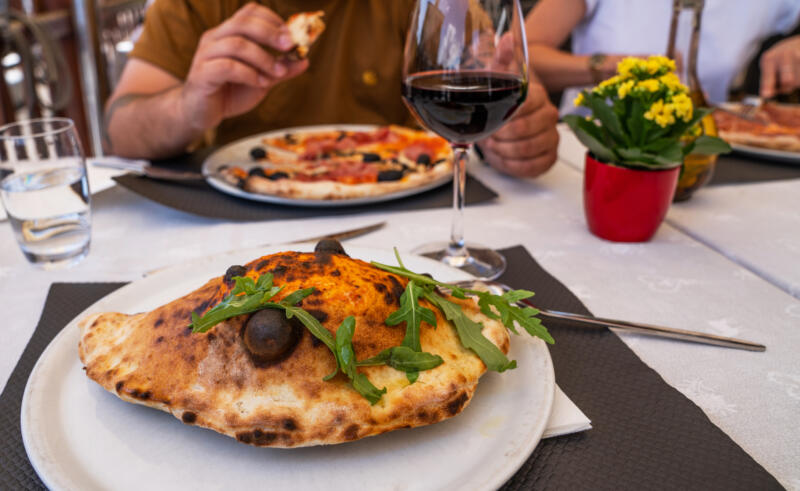
But as someone who’s spent years experimenting with both, let me tell you, the differences between calzone and stromboli are quite distinctive and intriguing.
I’d love to dive in and explore this topic further with you. So, if you’re ready for a deliciously informative journey, let’s get started.
In this article:
What’s a Calzone
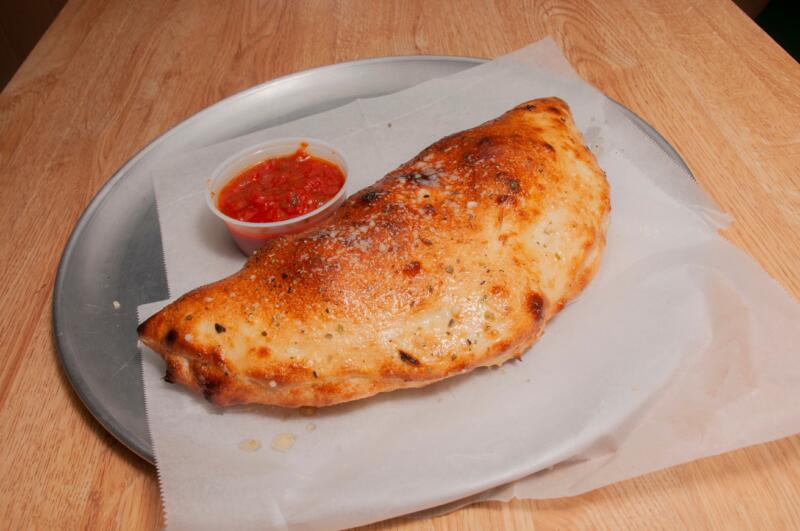
In essence, a calzone is an Italian dish made from pizza-like dough, but with an exciting twist.
Unlike the traditional flat and round pizza, the dough of a calzone is folded over and filled to the brim with a variety of delicious ingredients, giving it its iconic half-moon shape.
Picture an individual serving of folded pizza, yet incredibly satisfying and filled with surprises with every bite.
While some may argue that the holy trinity of calzone fillings consists of ricotta cheese, mozzarella cheese, and ham or salami, the truth is – the options are limitless.
Roasted vegetables, different types of meats, a variety of cheeses, and even sweet fillings, you name it, you can put it in a calzone.
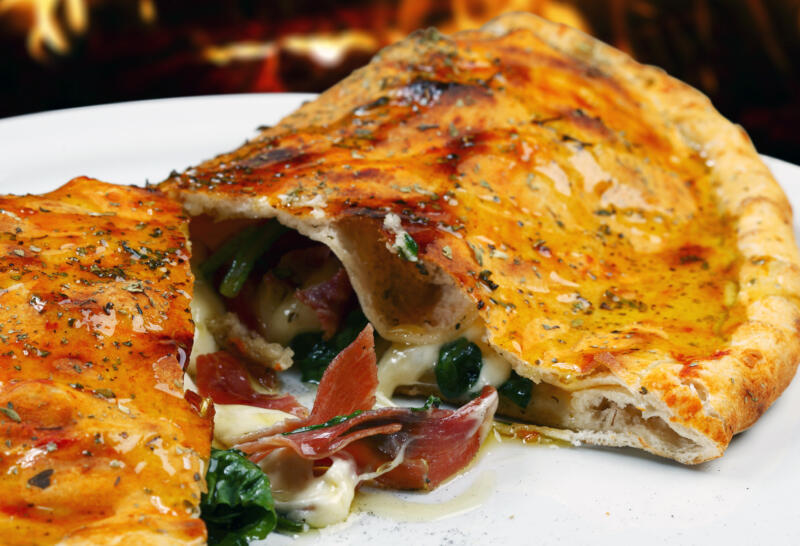
To complement this folded wonder, the calzone can be enjoyed with a side of marinara sauce or garlic oil, adding an extra layer of flavor that leaves you wanting more.
But a calzone isn’t just about its fillings. Oh no! The dough plays a crucial part in this Italian masterpiece.
A well-kneaded dough, made from high-quality flour, yeast, water, salt, and a drizzle of olive oil, not only gives the calzone its structure but also lends it a distinctive taste and texture.
However, creating the perfect calzone isn’t just about the ingredients; it’s an art in itself.
An important part of this art is the sealing technique. A proper seal ensures that all the delicious fillings are enclosed within the dough, making the calzone a parcel of gastronomic joy.
What’s a Stromboli
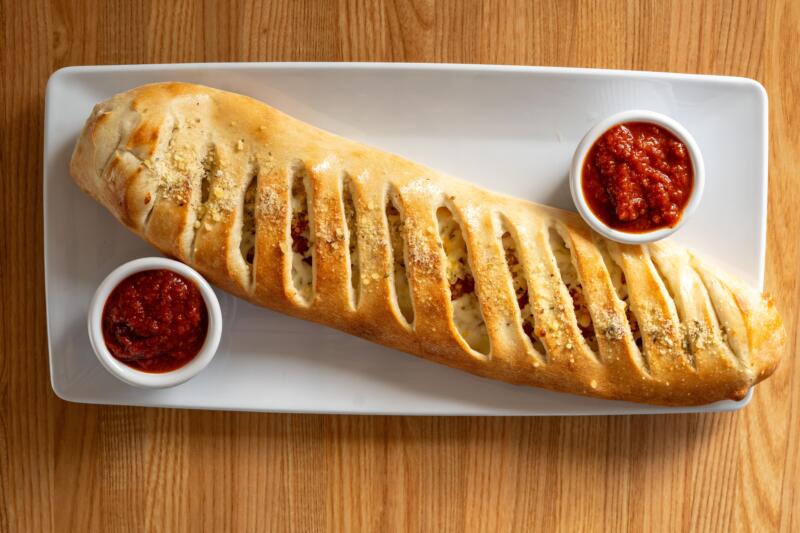
While the calzone hails from Naples, let’s take a gastronomic journey to another corner of Italy, or should we say, the United States?
Yes, you heard it right! Despite its Italian-sounding name, stromboli’s origins trace back to Philadelphia, U.S.A, in the 1950s.
Now, you might be wondering, what makes a stromboli different from a calzone?
The answer lies in its shape and the number of layers.
A stromboli is usually shaped into a cylinder. Unlike a calzone, which is more akin to a stuffed pizza, a stromboli is layered with ingredients and then rolled, resulting in a delightful swirl of flavors when you cut into it.
Speaking of flavors, what goes inside a stromboli?
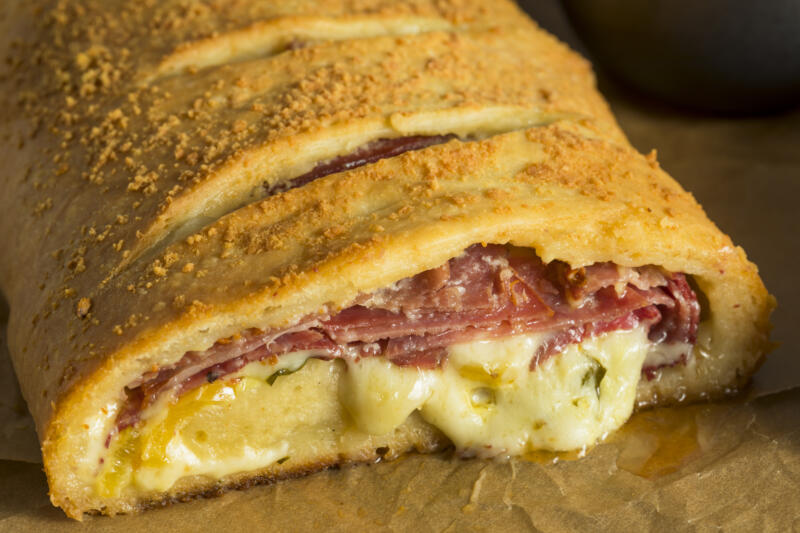
Much like its counterpart, the calzone, the ingredients of a stromboli are just as flexible.
Commonly, it’s filled with various meats like salami, capicola, and Italian bologna, paired with cheese and often, a tangy marinara sauce.
A stromboli is typically sliced into pieces and served as an appetizer or snack, but it’s hearty enough to stand alone as a meal.
Whether you prefer it with a side of marinara sauce, a dab of garlic butter, or even solo, a stromboli is a dish that certainly holds its own in the pantheon of Italian (or Italian-American) cuisine.
Major Differences
As we delve further into the world of Italian fare, it becomes evident that while calzones and strombolis may share some similarities, they also have some significant differences.
1. Shape
Let’s start with their shape, which is one of the most visible differences.
A calzone typically sports a half-moon or crescent shape, owing to the pizza dough being folded over the fillings.
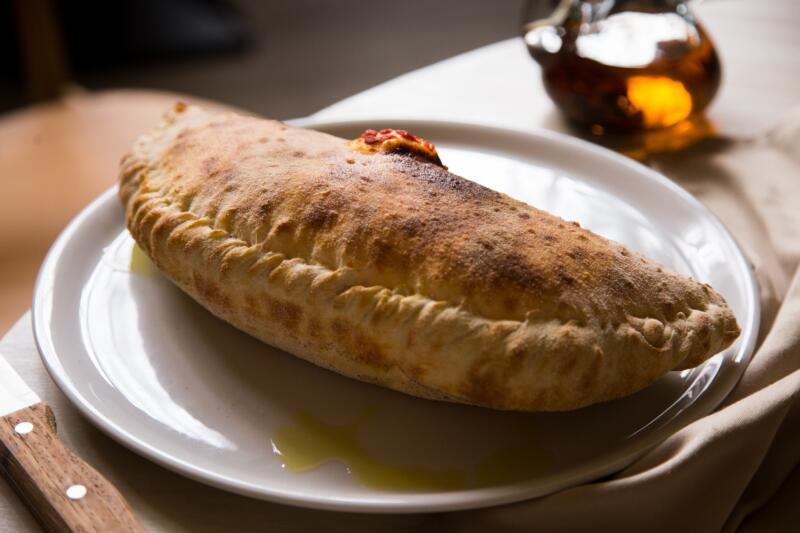
Its shape requires careful sealing techniques to keep all the delicious ingredients safely tucked inside.
On the other hand, strombolis are most often shaped like elongated rectangles or cylinders.
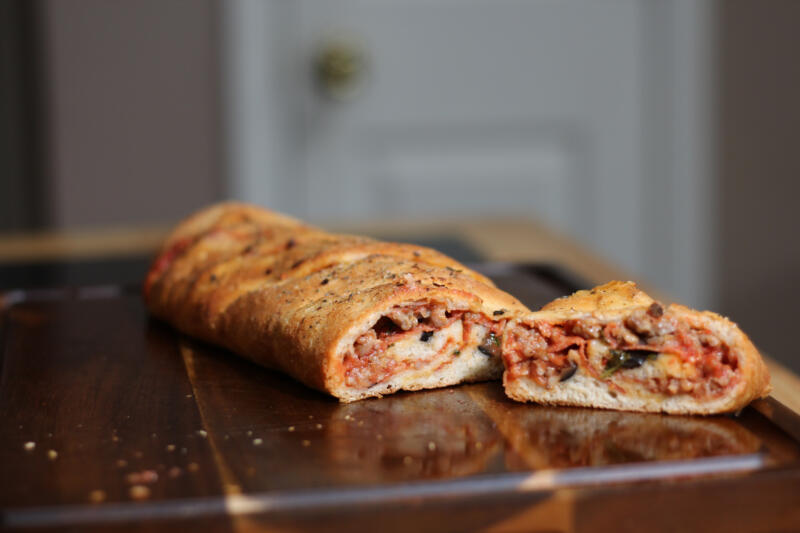
This shape is a result of rolling the dough around the fillings.
2. Size
The size of a calzone can vary. At various locations, Italian delis or street stalls offer calzones in a handy size, perfect for those looking to grab a bite on the move.
However, in many restaurants, calzones are served as a larger meal, not necessarily handheld, and can be enjoyed with a knife and fork.
So, while the calzone may have been designed as a portable, single-serving meal, it has evolved in different regions and contexts to include larger, shared versions of the dish.
Stromboli, with its elongated rectangular shape, is a dish that’s more communal.
A single stromboli can easily be sliced into smaller servings, making it the perfect dish to satisfy a group of hungry people.
3. Filling
While the fillings for both calzones and strombolis can be quite flexible, typically associated with pizza toppings, there are some key differences.
Both dishes commonly feature ingredients like meat, cheese, and vegetables.
However, the types of cheese used can vary significantly.
A calzone typically uses a blend of cheeses, including ricotta, adding a creamy texture to the filling.
Strombolis, however, lean towards mozzarella cheese for the filling, ensuring the moisture is kept at a minimum and the end result is gooey and delicious without making the crust soggy.
4. Sealing Techniques
Sealing techniques play a crucial role in the construction of both calzones and strombolis.
For a calzone, the dough is folded into a half-moon shape over the filling and then sealed by crimping the edges. This seal is crucial to keeping the fillings inside during baking.
In contrast, strombolis are rolled into a spiral with the fillings tucked inside.
The ends of the dough are folded over to secure the filling, creating a sealed cylinder.
Regardless of whether you’re making a calzone or a stromboli, it’s often recommended to brush an egg wash over the crust to help it achieve a beautiful, golden brown finish during baking.
Traditional Pizza Dough for Both Dishes
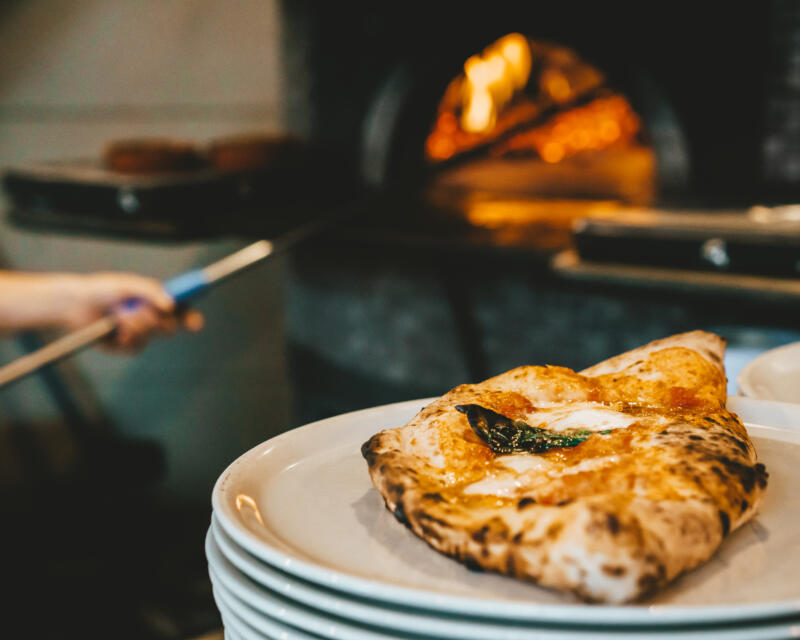
Traditional pizza dough is the cornerstone of pizzas, calzones, and strombolis, each offering a unique culinary experience.
For pizza, the dough is rolled flat, creating a crispy base and a soft top.
In contrast, for calzones and strombolis, the dough is folded or rolled around the fillings, forming a casing that needs to be sturdy yet delicate for even cooking.
This results in a crispy exterior and a well-cooked interior.
In the case of a calzone, the dough’s quality is crucial to prevent any raw sections, enhancing the texture and flavor.
The dough for the stromboli needs to be sturdy enough to hold its shape during baking, yet flexible enough to allow for rolling.
Ingredients of the Dough
Whether you’re creating a calzone or a stromboli, the dough ingredients play a significant role in determining the texture and flavor of the final product.
Traditional pizza dough, often used for both dishes, usually includes all-purpose or 00 flour, yeast, salt, sugar, and water.
Some variations might substitute the all-purpose flour with bread flour to get a chewier texture.
Occasionally, stromboli might use French bread dough, which results in a slightly different texture and flavor.
However, the beauty of these dishes is the liberty to play around with the ingredients to create a personalized masterpiece.
How to Make the Dough from Scratch?
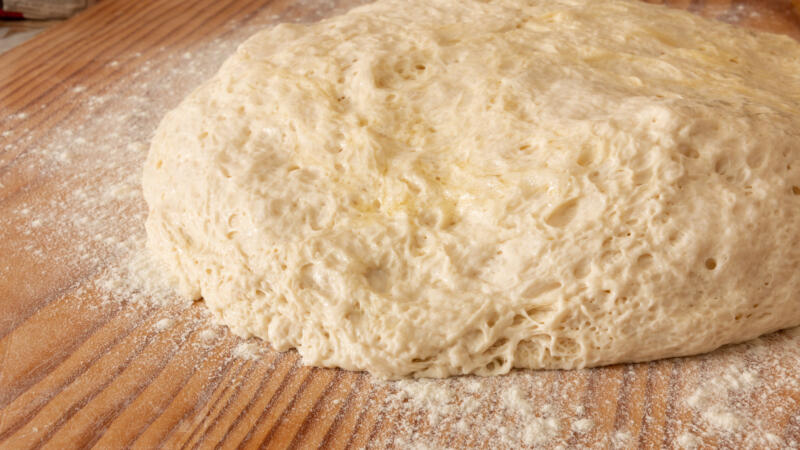
If you’re feeling adventurous and want to make your pizza dough from scratch, here’s a simple guide to get you started.
You’ll need some basic ingredients: all-purpose flour or 00 flour, a bit of sugar and salt, yeast, and water.
Begin by activating the yeast in warm with sugar. This helps the dough rise and gives it that airy, light texture we all love.
To properly activate yeast, the water temperature should range from 100°F to 110°F (37°C to 43°C).
Be cautious: overly hot water can harm the yeast, whereas too cool water might not stimulate it, potentially compromising your dough’s quality.
Meanwhile, mix your flour and salt. Once your yeast is frothy and active, combine it with your flour mixture and knead it until you get a smooth and elastic dough.
The dough then needs to rest, usually for about an hour or two, allowing the yeast to do its magic and the dough to double in size.
Remember, patience is key here. This is your time to prep your other ingredients, or maybe just relax with a glass of Italian wine.
All you need for this process is some basic kitchen equipment, like a mixing bowl, a clean surface for kneading, and a damp cloth to cover your dough as it rises.
Store-Bought Alternatives for the Dough
For those who prefer convenience or are pressed for time, there are several store-bought alternatives for pizza dough available.
Pre-made doughs, like those offered by Trader Joe’s or Pillsbury, are reliable alternatives when you want to whip up a quick calzone or stromboli.
While these alternative doughs may differ slightly in taste and texture from traditional homemade pizza dough, they offer a quick solution without sacrificing too much on quality.
The main differences often lie in the texture (store-bought might be less airy) and the taste (slightly less fresh).
Nonetheless, they can turn into delicious Italian dishes with the right fillings and a hot oven.
Extra Dough for Topping and Filling Purposes
When it comes to filling calzones and strombolis, it’s always handy to have a bit of extra dough at your disposal.
The recommended amount of dough can vary based on your preferred thickness and the number of fillings, but it’s generally best to aim for about a third more than the base amount.
It’s crucial to remember that while a bountiful filling can be tempting, overfilling can lead to a messy kitchen disaster, with the dough bursting during the cooking process.
Sealing and Cooking Properly
Sealing and cooking your calzone or stromboli properly are as important as choosing the right fillings. The process might require a bit of finesse, but with a few guidelines and some practice, you’ll be creating perfect Italian treats in no time.
Creating the Perfect Stromboli Shape
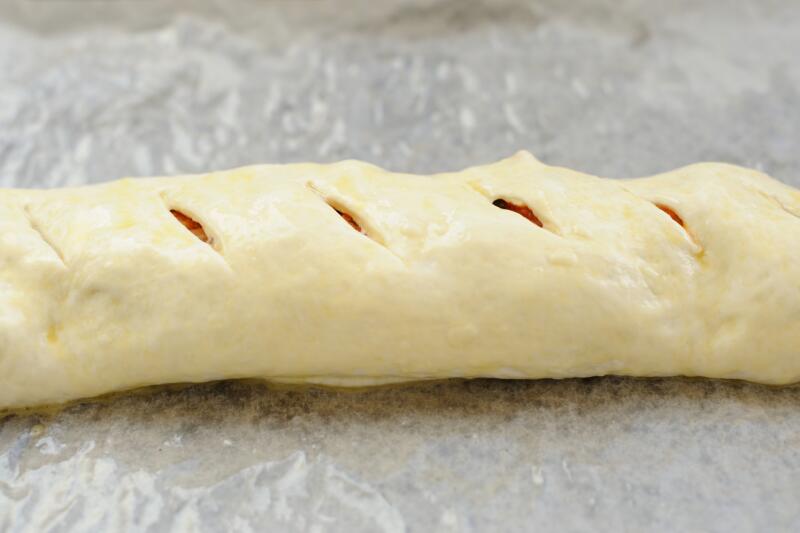
Start by rolling your dough into a rectangle and evenly distribute your chosen fillings, leaving a 1-inch border around the sides and bottom, and a 3-inch border at the top.
This is to accommodate the fillings being pushed forward during the rolling process.
Ensure that your dough isn’t overfilled, and maintain a boundary around the edge for sealing.
Stromboli’s Sealing in 4 Steps
- Apply an egg wash to all edges, which acts as a sealant.
- Gently roll the dough into a compact log, folding in the ends as you go. Ensure the roll is tight and secure.
- Once rolled, carefully move the stromboli onto a baking sheet. If the ends have come undone, pinch or tuck them in to seal.
- Give the stromboli another brush of egg wash and, if you wish, sprinkle on some optional toppings. Make 3-4 cuts on the top using a sharp knife to let steam release while baking.
Bake until it achieves a golden-brown hue, then let it cool for about 5 minutes before slicing.
Remember, the secret to a well-sealed stromboli lies in rolling it tightly and making sure the ends are properly tucked in.
Creating the Perfect Calzone Shape
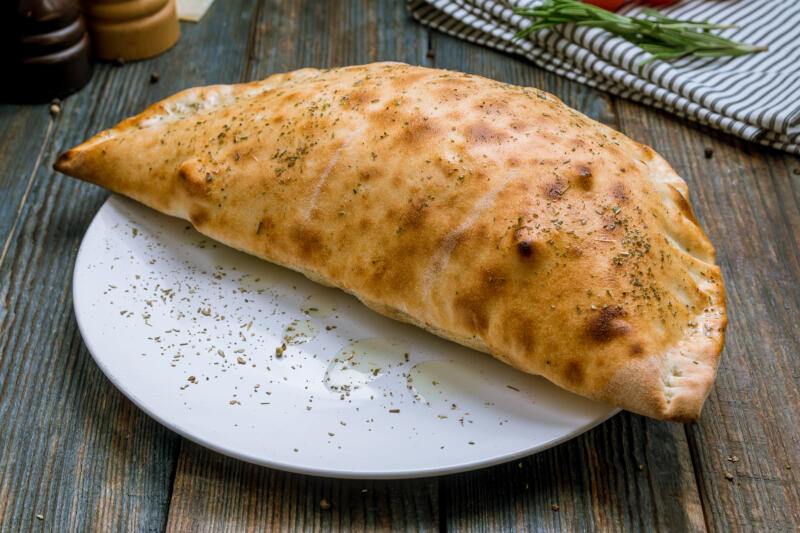
- Crafting the perfect calzone shape begins with rolling out your dough into a circle.
- Once you’ve got your circle, it’s time to introduce your fillings. Distribute them evenly over one-half of the dough circle, ensuring you leave a border around the edge. This border is crucial as it will become the seal of your calzone.
- Next, fold the unfilled half of the dough over the filled half, creating a half-moon shape.
Calzone’s Sealing in 6 Steps
For the best results, it can be helpful to let the dough rest a bit before sealing and make sure your filling isn’t too wet, which can lead to a weak seal.
Remember, the key to the perfect calzone shape is a secure seal – this keeps all those delicious fillings where they belong, inside your calzone. So, take your time with the sealing process, it’s worth the extra effort.
- Dampen the bottom edge with a bit of water or milk to facilitate a stronger seal.
- Initiate the sealing process from one corner, applying a firm pressure to create the first fold.
- Press down on the edges to seal, but be gentle – you want a secure seal without tearing the dough. For an extra secure seal and a bit of decorative flair, you can crimp the edges using your fingers or a fork.
- Maintain this technique, working your way around to the opposite end.
- Before it hits the oven, brush your calzone with an egg wash. This gives it a beautiful golden-brown finish and helps to seal the edges even further.
- To let steam escape during baking and to avoid a calzone explosion, don’t forget to cut a few small slits in the top.
Finally, bake your masterpiece in a hot oven or directly on a pizza stone until it’s browned and the filling is bubbly.
Closing Thoughts
Whether you’re a fan of the cheesy richness of a calzone or the layered textures of a stromboli, there’s no denying the joy that comes from crafting these dishes at home.
The process of making the dough from scratch, choosing your favorite fillings, and witnessing the transformation in the oven is an experience in itself.
I encourage you to roll up your sleeves, dust off your counter with some flour, and embark on your own Italian culinary adventure.
Whether you’re an experienced cook or trying these recipes for the first time, I’m sure you’ll find the process enjoyable and the results delicious.
I’d love to hear about your experiences, answer any questions you might have, or learn a new tip or two from you.
So feel free to leave a comment below.
Here’s to delicious discoveries and unforgettable meals!